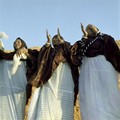Speculation around the shape of the Earth has been an ongoing debate since the dawn of time. Ancient Egyptians saw our planet as a flat piece of land enlightened by the sun, or «god Ra», who traveled through the sky every day.
In Greece, a similar belief was mentioned by Odyssey author Homer and poet Hesiod, who described Earth as a flat round disc encircled by an ocean. But around 330 BC, Greek philosophers started adopting the idea of a spherical shape. Aristotle brought evidence, debunking the idea of a flat Earth and his belief found its way to the Muslim world, where scholars were convinced that the Earth was everything but flat.
In fact, Muslims were among the first scholars to recognize the Earth’s sphericity. Influenced by Greek philosophers, several Arab scholars conducted numerous endeavors to prove the idea.
Estimating the Earth's radius
One of these attempts was the work of Persian scholar Abi Rayhan Muhammad ibn Ahmad Al Biruni. The Muslim polymath, who lived during the beginning of the 11th century, was one of the first scholars to estimate the radius and circumference of the Earth.

According to James S. Aber, Al Biruni «regarded the Earth as a sphere and computed its circumstance close to modern values». Historical accounts suggest that Al Biruni was in modern-day Pakistan when he managed to compute the radius of the Earth.
He estimated the radius of the Earth to «be about 6,339 km (...) which gives the Earth’s circumference to be about 39,830 km which is more accurate than Eratosthenes’ calculation of about 39,690 km», an article published by Thinkib revealed. The estimation of the Muslim scholar was only a few kilometers different from the current radius of the Earth, known to modern scientists nowadays.
An egg-shaped planet
But before considering the Earth’s radius, other Muslim scholars argued that the Earth was not flat. A book entitled «Nature Science and Sustainable Technology Research Progress» (Nova Publishers, 2008), mentions a different Muslim scholar who was convinced by the abovementioned idea.
The same book reveals that 9th century Persian geographer Ibn Khordadbeh mentioned in his book «Book of Roads and Kingdoms» (Kitab Al Masalik wa Al Mamalik) that «the Earth is not flat».
The same book further explained that the Muslim scholar thought that the Earth had an «egg like shape», which was badly translated into «elliptical», an «aphenomenal shape (…) that doesn’t exist anywhere in nature».
While Ibn Khordadbeh’s explanation was inspired by the Quran, other scholars had something to say about the shape of the Earth and Ibn Hazm was one of them. In a 2006 article, the Independent wrote that Andalusian polymath Ibn Hazm said that «the Sun is always vertical to a particular spot on Earth (…) 500 years before that realization dawned on Galileo».
Although Muslim scholars knew that the Earth is not flat, theories aimed at debunking this truth, that has been confirmed by modern science, are still circulating. Many people still believe that our planet is a flat piece of land, including members of "Flat Earth" societies.




 chargement...
chargement...












